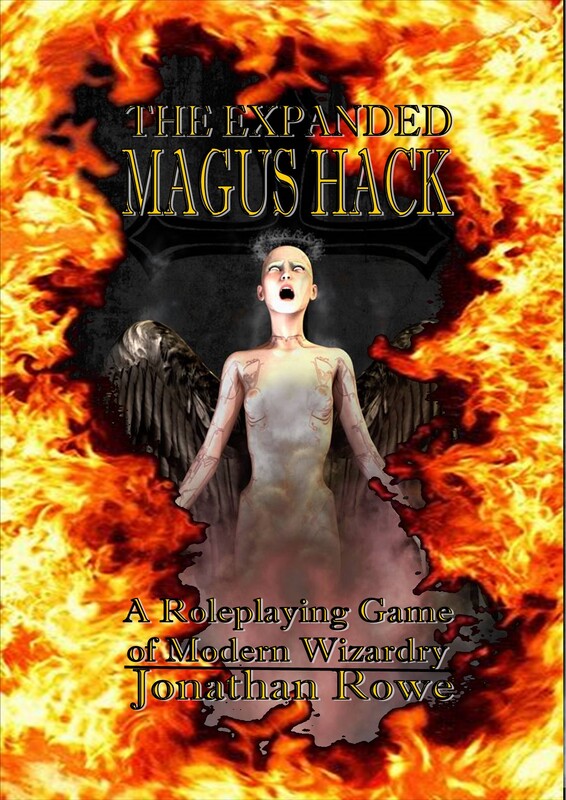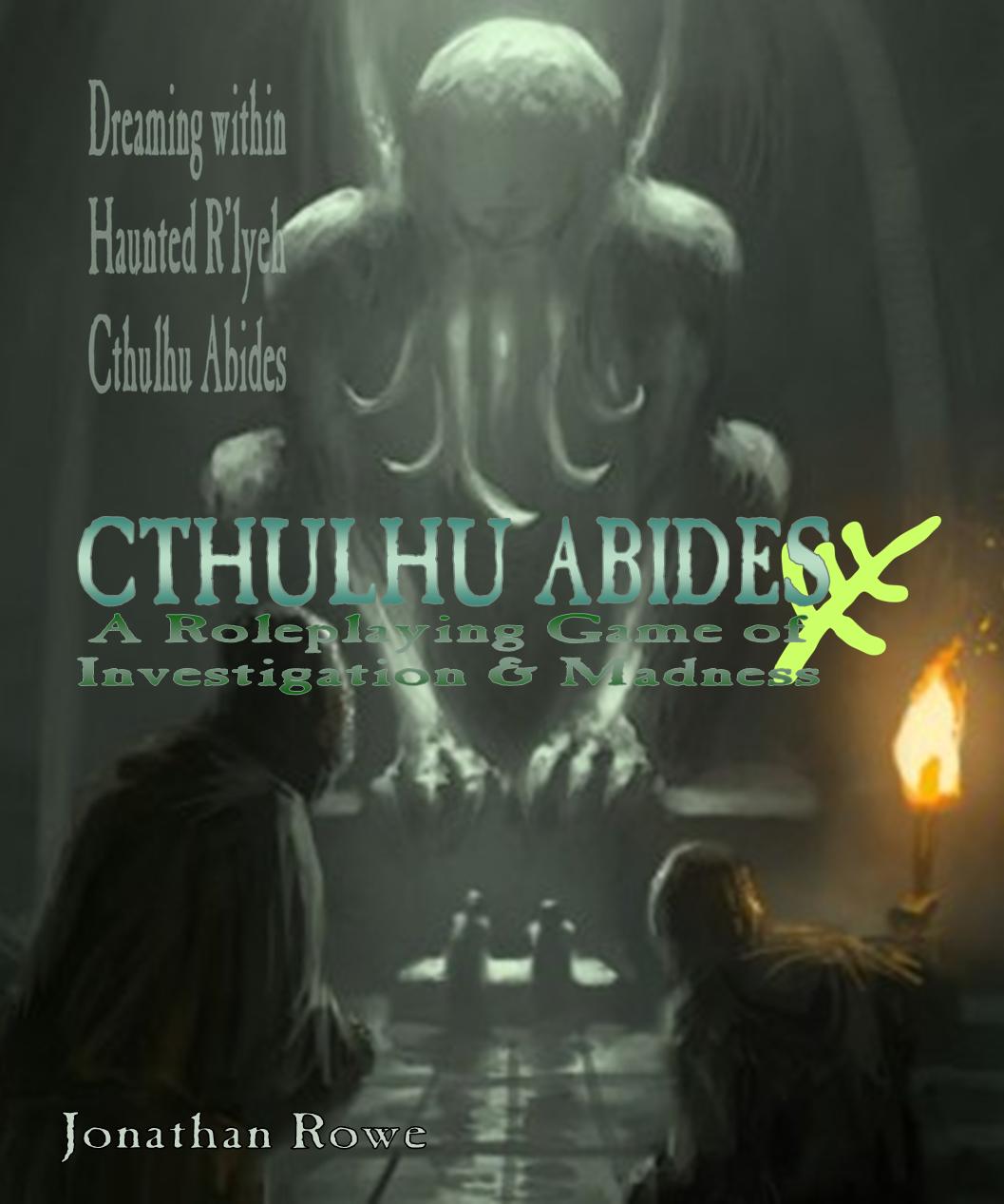|
Back in 2021 I published a little indie game called The Hedgerow Hack. You might be able to tell from the name that it borrowed the rules engine from David Black's influential The Black Hack. You can read about the inspiration on one of my earlier blogs. Turning Hedgerow Hack into Osprey's Through the Hedgerow involved a fundamental re-think. Hedgerow Hack had its origins in an old school D&D session, albeit one with a rural and faerie theme. In particular, it was inspired by one player character from that game, a child cleric named Bilge who worshipped a scarecrow. Hedgerow Hack was created in the first instance to allow Bilge to have further adventures in a world that seemed more suited to him. Here (above) is Karl McMichael's original character art for Bilge. I was delighted when the talented Peter Johnston incorporated Bilge into the artwork for Through The Hedgerow - there he is, spying on the Cailleach as the brew their potions and lay their plots. With this origin, Hedgerow Hack followed the broad parameters of D&D: PCs were adventurers, they equipped themselves with weapons, they confronted the forces of evil with force of arms, combat was the central feature of most scenarios, albeit combat with talking squirrels and undead farm labourers, taking place in windmills, manor houses, or stone circles on hilltops, rather than dungeons. The tone was quirky, but it was still D&D at heart. With Through The Hedgerow, there was the opportunity to build a brand new rules engine and a completely different conception of what an 'adventure' might involve. What I wanted to do, was de-centralise combat. I discussed in a previous blog post the inspirations for Through The Hedgerow and they were the TV shows and fantasy literature of my '70s childhood. What I didn't notice as a child, though it seems so clear now, was the strong theme of pacifism running through them. Not just Dr Who (that was actually quite a violent show by comparison); the Tomorrow People were literal pacifists. In Susan Cooper's The Dark Is Rising, Will's great powers as an Old One cannot defeat the Dark Rider by sheer force; in Greenwitch, Will's fraught negotiation with Tethys is awe-inspiring, but it is the child Jane's act of compassion that brings about a resolution. But surely the best illustration of this theme that knowledge and imagination always trump power and force - so alien to 21st century children's storytelling, which is rooted in the violent fantasies of the Harry Potter series - is the wizard Ged's confrontation with the Dragon of Pendor in Ursula LeGuin's A Wizard of Earthsea: Dragon of Pendor by Wild-e-Eep on DeviantArt It only now strikes me that Marvel's Dr Strange (2016) stole this very scene, when Strange confronts Dormammu, saying, "I've come to bargain." It's hard to imagine how one could go about setting up a moment like this in most fantasy RPGs, where to be a wizard means having lightning bolts at your fingertips and a Dragon (or Demon) is, at the end of the day, just a problem expressed in terms of Armour Class, Hit Points, and damage output. To be fair, there are other RPGs that have experimented with de-emphasising combat, Tales From The Loop, for example. It's a good comparison, because Loop features PCs who are all children. Hedgerow likewise introduces PC 'Waifs' who are innocent children drawn into the battle of the Light and the Dark. It's absurd to place child characters in violent conflict and repugnant to places players and GMs in the position of sending children to violent deaths - unless you want to run some grimdark, amoral game; I could envisage (but not enjoy) such things in a horror or cyberpunk style game. What I felt Through The Hedgerow needed was a rules engine that allowed even potentially deadly encounters to be resolved using all sorts of abilities besides weapons and physical force: fast talking, bluff, trickery, emotional appeals, mystic pronouncements, running away and hiding, and courageous defiance. The Checks & Challenges SystemOutcome Checks In a game like Through The Hedgerow, PCs succeed at most thinks they attempt and dice rolls aren't necessary. Every now and then something happens where the outcome is truly in doubt. This is the time to make an Outcome Check. The PC rolls any one of of their relevant dice and the Judge rolls a Peril Die; as a player, you just have to match or exceed the Peril Die. This isn't hard: most of the time the Peril Die is a d4, or a d6 at most; something really horrible has to be abroad in the night to roll a Peril Die bigger than that. If you fail an Outcome Check, you don't find what you're looking for or get to where you were going. I'm a big fan of a House Rule which says that you can salvage the situation just by spending Resolve equal to the difference between what you rolled and what you needed. If you do this, a player can usually turn a bad roll into a success, but it's draining to do so. That's a pretty simple system. You, the player, choose the Die based on how you roleplay the situation. If you're trying to talk your way out of trouble, roll Charm; if you're hiding, roll Wits; if you fight your way out or just outrun them, roll Might; if one of your Virtues looks relevant, roll your Virtue Die - and of course, you can always roll your Doom Die. If you've got a useful piece of Gear, that let's you roll d8 instead, or perhaps d6 if it's only marginally useful for the problem at hand. ChallengesChecks are easy but sometimes the problem is bigger, more complex, or threatens very nasty consequences. This sort of problem is a Challenge and there's a different system for that. Every Challenge has a Threat Level (TL), from TL0 up to TL5. This indicates how many steps or episodes are needed to resolve it. Picking a lock might be TL0, just a single Threat, but being attacked by a pack of hungry wolves might be TL2, indicating three Threats in succession. I find myself wondering now why I insisted on calling the first Threat Level TL0 instead of TL1. There are reasons for it, but now that I look back, they don't seem like good enough reasons compared to the intuitive simplicity of saying that TL1 is a single Threat . Maybe future editions will correct this terminology. Players get to describe how their PCs deal with each Threat. In a sense, they become the games masters and take up the narration. You might say, "I pick up a burning branch from the fire and wave it towards the wolves!" or you might say, "I climb a tree to get away from them!" or even, "I look deep into the wolf's eyes and commune with its wild spirit." If it fits the situation and your character, you can describe it. The Threat then dishes out Peril, which is deducted from your Resolve score. This wolf pack might roll a d6 Peril, but the Judge might rule that climbing a tree is a good idea and the Peril shrinks to d4 for that character. If you don't want to lose Resolve (and usually, you don't) then you can roll dice to try to 'soak' the Peril. You can roll dice based on any relevant Quality, Gear, or Virtue. You can roll your Doom Die. You can roll a die for any of your personality Traits that apply. Using the burning branch might be worth a d6 (it's not really what the firewood is for which is why you don't get a d8 for it); climbing a tree might justify rolling your Wits Die; communing with spirits would use your Charm Die or perhaps your Gramayre Die, or both. You use the highest result and deduct it from the Peril, hopefully you won't lose any Resolve. This happens for the next Threat, and the next, until all the Threat Levels have been experienced. If you lose all your Resolve, you are defeated; if you're still standing at the end, you win, and the wolves retreat, or your escape them, or their leader submits to your authority. The catch is, most dice get exhausted after they are used, so for subsequent Threat Levels you have to change tactics, or else justify what you are doing in a new way. Maybe for TL0 you look into the wolf's eyes and roll your Charm and Gramayre. For TL1 you declare, "I'm overwhelmed by the beast's hunger and I stagger, but I find a reserve of strength in myself and maintain eye contact!" and the Judge agrees you can roll your Might this time. For TL2, you suggest, "I offer the wolf a sandwich from my satchel," and the Judge decides this is worth a d6 too. Assuming you didn't lose all your Resolve, the Challenge ends with the wolf leader devouring your sandwich, then the pack leaves you in peace. This is how a PC schoolboy can overcome the challenge of a pack of hungry wolves armed with a sandwich. Hazards, Humours & SuccessesSome Challenges don't just drain your Resolve. Hazards are penalties you suffer if you lose any Resolve to the Challenge. For example, the wolf pack might have the 'Injury' Hazard, which means that, if you lose even 1 point of Resolve, one of your own dice is 'burned' and is treated as a size smaller until you get healed. The Judge might ignore some Hazards based on the way you roleplay your behaviour. Climbing the tree or waving the burning branch around definitely risks an injury, but a sympathetic Judge might rule that communing with the wolf's spirit does not (at least not while you're using Charm rather than Might). Humours alter the way a Challenge works. For example, the wolf pack might have 'Armoured' which means any dice you use to soak their Peril that are based on force or combat are treated as a size smaller. Once you've passed all the Threats, you enjoy some sort of success, probably a 'Modest Success' which means the problem is over for now but it will soon return or be replaced by another one just as bad. You can make your Success more effective by generating 'edges' which you do by choosing to shrink you largest die before you roll it. Some Virtues and Gear also confer edges when used. Edges might turn a Modest success into a Minor, Major, or Outstanding Success. In the example above, the wolf pack might communicate important information to you before they leave - or even accompany you as an Ally for a while. Challenges generate 'notches' which counteract edges - one for each Threat Level after the first (which is why I call the first Threat 'TL0' as it generates no notches). There are Humours and Hazards that generate notches too. If you end up with more notches than edges, you enjoy only a Partial Success, a Bare Success, or No Success at all (which forces you to face the Challenge again). Putting It All TogetherThe Challenge System is very different from the turn-by-turn resolution systems of games like D&D. It draws some inspiration from Blades In The Dark's system that bundles all the various possibilities of a problem into a single dice roll based on position and effect, then ticks of segments of a 'clock' to mark progress towards a goal. Similarly, the Challenge System assigns a Scope value to the Challenge and to the PCs involved in it. A single person has a Scope of 1, two or three people would be Scope 2, four to six would be Scope 3, and so on. If the Challenge has more Scope, then the difference is used to increase the Threat Level or the Peril Die, or both. That TL2 Pd6 wolf pack from earlier might be Scope 2. A lone PC up against that many wolves might find the TL increased to 3 or the Peril Die increased to d8, whichever makes things more dramatic. You can ignore Scope when size and numbers don't amount to an advantage - climbing the tree, for example. In the same way, if the PCs have more Scope, they can reduce the TL or Peril Die. Four PCs confronting the wolf pack could reduce it to TL1 or Pd4. I've loaded the Challenge System with enough nuances to account for players who want to be armed combatants, so you can use it for big skirmishes or flamboyant duels (in the Princess Bride style). Martial characters can take Virtues which let them un-exhaust the dice they get from armour and weapons or earn extra edges with certain weapons or manoeuvres. For example, troll-like Buggebers count as two people for purposes of working out Scope and gain an extra edge when using their claws. Unlimited Dice are rare, but these dice don't exhaust until the end of a Challenge, so you can use them over an over again, against each Threat as it arrives. Your Doom Die becomes Unlimited under certain conditions. The Challenge System is also used for casting ritual spells or performing Glees (magical songs) or winning Riddle contests. RestingPCs will want to get their lost Resolve back and un-exhaust the various dice they used in Challenges. For this, there are different types of Rest. A Breather is a short rest. You spend a couple of minutes catching your breath, checking your injuries, restoring your concentration or peace of mind. You restore 1 point of Resolve and un-exhaust all your personal dice and the dice for any light equipment (including light armour and light weapons). Martial characters often un-exhaust other weapons or armour too. A Respite is a bit more protracted, more like half an hour, which means a chance to repair equipment, treat wounds, have a quick nap, etc. You restore all your lost Resolve and un-exhaust all dice. You can do special activities in a Respite, like cooking up schemes, hunting for herbs, or sharing a nice cup of tea (which lets you re-roll your Resolve, selecting the better result). The only catch is that, during a Respite, the dread Nemesis advances and the forces of the Dark get stronger. Fortunately, many characters have 'Free Respites' they can use to avoid this penalty. There are also Interludes, lasting several hours, in which mortals get to sleep and everyone can undertake more protracted chores. The Nemesis always advances during an Interlude. Adventures in Through The Hedgerow have a timer built into them. There's a Nemesis Die that starts quite small (like, a d4) but gets bigger every time you take a Respite and in other circumstances where the Dark gains power. When the Nemesis Die gets to d10 or d12, Challenges involving the Dark become especially difficult. If the Die increases past d12, the PCs have failed in their mission, but might be able to seek a final encounter with the Dark's powerful Emissary (and you'll need good luck to win a Challenge against one of them!). And then there's DefeatEven if you de-centralise violence, PCs will still sometimes lose and there need to be consequences for that. Not every Challenge involves the threat of injury or death, but something needs to happen. Then there's the issue of child protagonists who shouldn't be brutalised by the grievous outcomes that threaten adult combatants. My solution is to create a selection of 'Defeat Caps' ranging from 'Distraction' (you're a bit weak until you get a Respite), through 'Stricken' (where you burn your Dice until you get prop[er healing) and 'Capture' (where you're out of the story for a while) and ultimately 'Vanquished' (where you're out of the story for the rest of the adventure). In the example with the wolf pack, the character swinging the burning branch risks being Vanquished or Stricken (as the wolves tear into him); the PC in the tree risks being Captured (if she can't get back down); the character mystically communing with wolf spirits might be Distracted or Weakened. But even that isn't guaranteed. Players get to argue for a lesser Defeat Cap they find preferable and make a sort of saving throw called a Defeat Check. If ithe PC passes the Check, things work out as they describe it. PCs who are Waifs (child adventurers) can substitute being Captured for any serious Defeat Cap. Remember in the Lord of the Rings, where Boromir was vanquished, but the innocent Merry and Pippin were captured by the Orcs, only to escape later? This approach gives players a huge amount of agency. You get to describe the drama of the Challenges you face and select dice that match your description. Even if you are Defeated, the consequences of your defeat match the sort of drama you envisaged, and if you don't like that you still get a chance to substitute those consequences for more congenial ones. Does this make Through The Hedgerow a 'fluffy' sort of RPG where nothing truly bad ever happens to anyone? No, characters can be Vanquished easily enough. A lot depends on the tone the Judge wants to established: gritty and dangerous, or romantic and whimsical, or somewhere in between. Even Wind in the Willows has episodes of terror and danger: chapter 3 (The Wild Wood) places Mole in serious peril until Rat rescues him and they find safety at Badger's home. The eyes! Richard Johnson's excellent illustration of Mole alone in the Wild Wood with ... Them! Moreover, you can absolutely create martial characters: be-clawed Buggebers, tragic Hodkin, warrior-wizard Ouzels, grim Motley murtherers, and holy warrior Heathen Clerks. But even for these characters, combat can involve speeches, emotional appeals, curses, and dramatic flourishes, rather than just relentless pummelling. The point of these unusual rules that depart from the conventions of fantasy RPGs is that players are liberated from caution and concern over safety. You can confront the evil Witch-Hunters with a thundering denunciation, you can appeal to the honour of a crazed berserker, you can commune with the spirit of a ravenous wolf. Or at least, you can try and you don't need to be held back by the worry about what might happen if you fail.
0 Comments
Leave a Reply. |
30 Minute Dungeons
Essays on Forge
FORGE Reviews
OSR REVIEWS
White Box
THROUGH THE Hedgerow
Fen Orc
I'm a teacher and a writer and I love board games and RPGs. I got into D&D back in the '70s with Eric Holmes' 'Blue Book' set and I've started writing my own OSR-inspired games - as well as fantasy and supernatural fiction.. Archives
July 2024
Categories
All
|















 RSS Feed
RSS Feed
